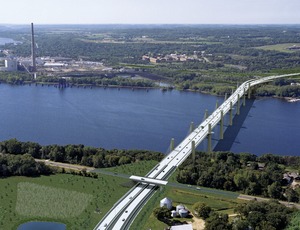
It has traveled a long, bumpy path, but a controversial proposal to build a major bridge between Minnesota and Wisconsin has moved a giant step closer to a groundbreaking. Congress has cleared a bill exempting the estimated $626.4-million St. Croix River bridge from the requirements of the Wild and Scenic Rivers Act. The 1968 statute bars federally funded projects that would harm such rivers' scenic qualities.
The Senate approved the bridge measure in January. Final congressional action on the bill came on March 1, when the House passed it on a strong, bipartisan 339-80 vote—a rare event in this Congress. The bill now goes to the White House.
While the Obama administration has not taken a position, the bill is supported by some political heavy hitters from both sides of the aisle: the governors and U.S. senators from Wisconsin and Minnesota and Dept. of Transportation Secretary Ray LaHood, among others. In a statement, LaHood said the project would provide a "critical new transportation option to the citizens of Minnesota and Wisconsin."
According to Minnesota DOT estimates released on March 1, the project will include $405.4 million for construction and $90 million for engineering and management. The agency says the total cost could range from $571 million to $676 million.
Even at the low end of that scale, the multiyear job would provide a big lift to design and construction firms. "This is really good news, welcome news for us," says Tim Worke, highway and transportation division director for the Associated General Contractors of Minnesota. He says Minnesota has lost more than 50,000 construction jobs since its 2006 peak.
Patrick Goss, Wisconsin Transportation Builders Association executive director, says the plan has several major components. "There's not just bridge work on this project," he says. "There's approaches, highway work that's going to need to be done, earthmoving work."
The plan should lead to opportunities for a variety of subcontractors and crafts, Worke says. "It means that you won't just have a few operating engineers and a couple of laborers like you'd have employed on a $10-million, four-mile bituminous overlay project," he says. "You're going to have all the trades."
The preferred option described in a 2006 environmental impact statement is a four-lane, extradosed bridge stretching 4,953 ft between the Minnesota and Wisconsin abutments. An extradosed bridge is described as a cross between cable-stayed and box-girder designs (ENR 2/20 p 12). Compared to other designs, the extradosed option has fewer piers in the river and the height of the towers above the deck is reduced, the EIS says. The new bridge would replace the two-lane Stillwater Lift Bridge, built in 1931 about a mile north of the new structure's envisioned site.
The project has critics, including Rep. Betty McCollum (D-Minn.), who said it would result in a "megabridge" that is too expensive and would link two small municipalities with a combined population of about 5,100.
Environmental groups have fought the plan. The just-passed bill provides what is believed to be the first-ever waiver of the Wild and Scenic Rivers Act prohibition on federally funded water-resources projects that have "a direct and adverse effect" on "values" of rivers designated wild or scenic.




Post a comment to this article
Report Abusive Comment